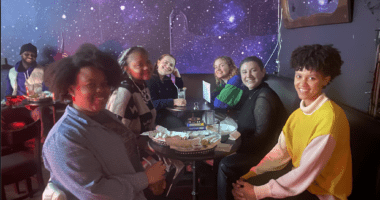In this ongoing series, Katie Rainey, reports from inside the Teaching Artist Training and Internship Program. A graduate of the program, Katie shares her insight into the workshops, seminars and personal experience with classroom internships.
On Saturday November 8th, 2014, the Teaching Artist Training & Internship Program (TATIP) held the third in a series of workshops for beginning and advanced Teaching Artists. This time they shook things up and changed perspectives.
The new trainees started off at Church Street School for Music and Art, while the advanced group met at Community-Word Project headquarters near Bowling Green. This allowed the novice trainees to spend more time learning the ins and outs of basic lesson planning and objectives. The seasoned Teaching Artists spent time discussing the Common Core, teaching paths, igniting the spark, curriculum development and more.
The workshops began with an opening ritual: Sequencing. The trainees were asked to work silently and arrange themselves in a line according to height. This first sequence was simple. Through silent cues they moved from tallest to shortest in a matter of minutes. They were then asked to create more complex sequences, again in silence. They alternated tallest and shortest every other person. They worked as a team to create new shapes and lines, each taking turns acting as a kind of “silent leader.” Sequencing is a technique to change students’ thinking patterns and encourage teamwork to build a classroom community.
After the opening ritual, the new trainees buckled down and dove into a rigorous day of preparing an arts-based pedagogy. They reviewed lesson plan construction and scaffolding, inquiry questions, objectives and templates from the previous workshop and talked about the stages of Child Development.
Trainees studied Jean Piaget’s Stages of Cognitive Development, breaking down each classroom grade and age by social behavior, cognitive growth, motor abilities, etc. This practice helps Teaching Artists assess the best approach to translating their creative processes to a student and determining how each student learns most effectively.
“Learning that I can create a lesson plan sparked from my deepest motivations and passions has been a complete revelation; that which moves me as an artist will move me as a teacher- so powerful!”
– Kim Baglieri, Mixed Media Artist/Writer
After lunch, the advanced trainees joined the group at the Church Street School for an afternoon of deep reflection. Teaching for Social Justice is a central part of what we do at Community-Word Project, making sure that each student is aware of their own voice, the voices of many, and the power of those voices.
First, we watched Ngozi Chimimanda’s TED Talk, “The Danger of a Single Story.” Chimimanda’s talk focuses on the idea that our lives are made up of overlapping stories. She warns that if we hear only a single story about another person or country, we risk a critical misunderstanding. The talk ignited strong emotions within the group. An intense reflection on Social Justice in the classroom followed.
“I enjoyed the thought provoking conversation regarding stereotypes. It really forced me to take an honest look at how I view the world (consciously and subconsciously) and the effects that will have on my students.” -Shereen Macklin, Theatre Artist
The final part of the workshop was devoted to teaching partners splitting off and developing a lesson plan to be presented at the next workshop. The objective is for teaching partners to present an abridged version of their lesson plans. The group will then “workshop” them, refine them, and eventually the trainees will execute them in their residency internships.
Each Community-Word Project classroom has two Teaching Artists, one writer and one artist of another art form, as well as up to three TATIP interns. TATIP models it’s teaching in this way and this is why our trainees are taught to co-plan and co-teach a lesson.
On Saturday November 22nd, TATIP will reconvene for the fourth workshop where nine different teaching partners will present their collaborative lessons. This is always an exciting day because we each get to experience a fresh and exciting approach to teaching arts in the classroom.
“This program has challenged me as a person and expanded me as an artist, not to mention showing me how to translate my creative process into a teaching practice. I’m really grateful for the experience.” – Dan Paul Roberts, Visual Artist



